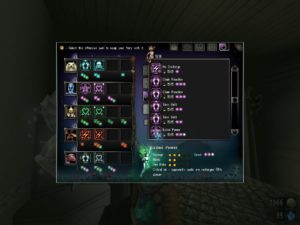So, let’s get back to this. I think I’m approaching the end, partly because I’m running out of new fairy elements to acquire, but mainly because Rafi, the helpful goblin NPC who you can always talk to to find out what you’re supposed to do next in order to advance the plot, basically told me that at this point I should finish up any side-quests I’d been putting off. It’s been a while since I played, so I think it’s a good idea to refresh my memory about the plot. I am by now fuzzy on many of the details, and writing down everything I remember will help me to clarify what I need to re-learn.
As you may recall, the realm of Zanzarah was menaced by some great unknown evil, which produced an invasion by Shadow Elves , hostile wild fairies, and roadblocks of various sorts such as large rocks and thorn bushes. (In grand Zelda tradition, plot-crucial battles often yield the tool necessary to overcome one type of obstacle.) A prophecy told of a human hero that would rectify things, so Rafi went and arbitrarily brought Amy into Zanzarah, apparently figuring that one human is as good as another. After some acts of heroism in the Elf and Goblin territories, she was advised to consult with the powerful White Druid, who no one had seen in some time. The White Druid turned out to be in the Realm of Clouds, a floating land of marble ruins, home only to wild air-type fairies and some Shadow Elves that had got there somehow.
The White Druid appears to be human. (Apart from Amy, he’s the only person in Zanzarah who’s more than four feet tall.) This is strange, because there are quite explicitly no humans in the land of Zanzarah. There used to be humans, but they were supposedly all driven out ages ago for acting like dicks. Perhaps the other Zanzarans don’t know he’s human? Like I said, he’s been isolated in the Cloud Realm for some time.
The White Druid showed me an arena where there was a Shadow Elf boss fight. The pre-battle banter implied that the Shadow Elves were in league with the dwarves, and the loot included a staff known to belong to the dwarf ruler. Already this seemed suspicious to me, but the news got out quickly (I’m not sure how), and there was an immediate call among the public to punish the traitorous dwarf king and probably expel his entire race, just like they did to the humans. The dwarves, of course, pleaded with the prophecied hero to help them prove their innocence, and shortly afterward Rafi expressed the opinion that the White Druid himself framed them.
Now, here’s the bit that I’m particularly fuzzy on: There’s an entity called the Guardian. It may be the end boss, the Sauron to the White Druid’s Saruman. Apparently it was created to protect Zanzarah, but it’s gone haywire, and is the real source of all the problems. In particular, it decided that maintaining the status quo requires preventing the prophecy of the human hero from coming true, and created all those roadblocks specifically to retard Amy’s progress. So it’s one of those self-fulfilling things, because these safeguards against the Prophecy are the only reason Amy’s there in the first place. To make it even more circular, the Prophecy was apparently invented specifically to give Rafi an excuse to keep in contact with the Human world just in case something went wrong with the Guardian. Or something like that.
If the Guardian is in fact the end boss, it’s not clear to me whether it has fairies under its control or whether I’d be fighting it directly. The latter would be kind of strange, because the game has no combat mechanics for anything other than fairy duels, and the few pictures I’ve seen of the Guardian so far make it look more like some kind of weird clockwork apparatus. But then, the fairies themselves have been getting stranger and more monstrous at this point. The abandoned dwarven workshops have artificial robotic fairies, which can be captured like any wild fairy, and then upgraded; after two upgrades, you have a robotic fairy torso on the body of a metal scorpion. In the more advanced forest areas, there’s a new Nature-type that’s half-whelk, half-jabberwock. It gave me quite a start when I first saw it.
 Comments(3)
Comments(3)